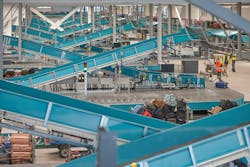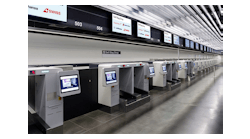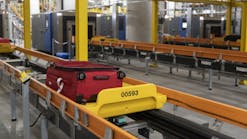Zurich Airport Expands, Upgrades Baggage Handling System
A $160 million baggage handling system expansion and refurbishment project underway at Zurich Airport (ZRH) will result in one of the largest and most advanced baggage handling systems in the world.
The expansion includes an area of about 18.6 square miles and, running mostly underground, the system will connect all of the airport’s terminals. Technology upgrades will allow Zurich Airport to meet the latest security standards, improve reliability and expand capacity.
To date, design, development, procurement, manufacturing and installation activities have primarily been finished, said Ravi Singh, head of Business Development & Sales – North America (Airports), Leonardo Group.
According to Jasmin Bodmer-Breu, senior media spokesperson, corporate communications, Zurich Airport, part of the new system will go live in November, while part of the old infrastructure is being deconstructed, and the project will continue in stages until it is completed at the end of 2027.
When ground was broken for the project in March 2018, the airport said in a news release that the expansion and upgrade of the airport-wide baggage handling system was necessary to keep pace with the expected increase in passengers and to make room for larger security screening technology. The airport also pointed out that essential parts of the existing system would be nearing the end of their service life in 2022.
“Currently, we have a theoretical maximum capacity of about 7,500 bags per hour, however, that heavily depends on flight traffic, number of inbound / outbound flights etc., so numbers may vary strongly. The new infrastructure will increase our maximum capacity by about one-third,” Bodmer-Breu said.
Leonardo, working in consortium with Austrian company Motion06, was issued the contract for the project. Leonardo was awarded about $128 million and is responsible for overall project management, system design and integration, as well as the supply of cross-belt sorters and IT systems, while Motion06 is supplying conveyor modules and equipment.
The Leonardo baggage handling system design includes:
- Eight Multisort Baggage Handling System (MBHS) cross-belt sorters (which replace legacy tilt-tray sorters) with 80 induction lines for a total length of about 2.5 miles
- About 4.3 miles of high-speed conveyors for inter-terminal connections with a speed of 20 feet per second (6 meters per second) (replacing a legacy individual carrier system)
- About 7.5 miles of traditional conveyors
- Conveyor-based early baggage storage for 2,000 bags
Singh said unique features of the new system include variable speed control for optimizing baggage throughput, the ability to dynamically recenter the position of baggage on the sorter, high-precision sorting for active control of loading and unloading, and the ability to handle all types of baggage including fragile bags and oversized or bulky items.
The Multisort Baggage Handling System (MBHS) from Leonardo uses linear motors to move baggage on continuous loops with induction lines for loading and unloading baggage. Each bag is loaded onto a square “cart” that has a horizontal motorized belt (or “cross-belt”) for bidirectional loading, transporting and sorting of baggage for its assigned destination.
Technologies, such as inductive power distribution and Wi-Fi data transmission to control onboard devices, enable high reliability and eliminate the need for dedicating hardware (gears or drive belts) to the divert points. According to Singh, destinations can be added or moved easily.
Most of the airport’s existing baggage handling system’s electromechanical and IT components are being replaced.
Singh outlined three IT innovations of the new system:
- Advanced IT systems for management – (The modular software suite can manage all baggage handling functions including outbound, transfer and inbound.) All the control systems and the baggage reconciliation system are ready for integration with the upper-level IT systems of airport information technology infrastructures. The standard set of messages defined in the IATA recommendations are implemented by the Leonardo IT components. The SCADA is based on a top-level commercial platform and is ready for integration with global airport monitoring systems through standard protocols.
- Flow management software for intelligent routing
- A unique diagnostic system based on a network of Internet of Things (IoT) sensors with a “big data” analysis mechanism for predictive maintenance.
Leonardo's experience in the airport sector also has been recognized through contracts with airports in Rome, Milan, Frankfurt, Geneva, Paris, Kuwait, Hong Kong as well as other locations. Singh said Leonardo plans to mirror its European and Asian success by further expanding in the North American market.






